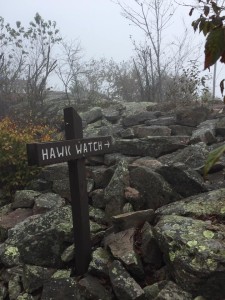By guest blogger, Aidan Griffiths ’22

There’s nothing quite like Fall hawk migration. Hundreds of thousands of birds of prey take advantage of the favorable Autumn winds and migrate south for the winter, sometimes grouping together in flocks of hundreds or even thousands of individuals at a time. Many enthusiastic observers gather each year to watch this amazing phenomenon, and it just so happens that Central Pennsylvania is one of the best areas in the country to do so. These majestic birds follow the abundant mountain ridges in Huntingdon and surrounding counties because the updraft of air off the mountain slopes helps them achieve lift. They also ride the warm currents of air, called thermals, that rise off the surrounding land. This allows observers to get fantastic views of many raptor species as they ride these thermals to the top and sail over the mountain. On October Seventh, the Juniata College Chapter of the Wildlife Society traveled to the Stone Mountain hawk-watching site in northern Huntingdon County to do just that!
Seven of us Wildlifers met bright and early (for a Sunday) at 9 AM behind Brumbaugh Academic Center. We took inventory, did some quick introductions, and carpooled up to Stone Mountain. On the ride up, we weren’t very optimistic about our chances of seeing good raptor activity. The winds were blowing from the South, which is the wrong direction for birds that want to end up there. Perhaps more to the point, there was a pea-soup fog that seemed to get thicker the farther up the mountain we got. When we finally got out of our vehicles, we could barely see six feet in front of us, and the rocky path leading up to the hawkwatch was wet and slippery. Nevertheless, we made the brief trek up to the platform. The view we had was such that we wouldn’t have been able to tell a hawk apart from our left knee, but we did have some nice birds at the summit. A small flock of Dark-eyed Juncos, White-throated Sparrows, and other songbirds greeted us with little chirps and squeaks while we waited for the mid-morning sun to burn off the fog. Our formal guide, Luke Fultz, had informed the leaders earlier in the morning that he wouldn’t be arriving until ten o’clock, and we were starting to wonder if we should have done the same. However, as the warmth of the rising sun increased, the fog burned off and blew away, and were left with a gorgeous view of Central Pennsylvania valleys and Jack’s Mountain on the ridge opposite us. And, of course, the dissipating fog heralded the arrival of our birds!

At about 10:30, we started seeing our first migrants. A group of four Tree Swallows passed daintily overhead heading south. Several groups of Turkey Vultures started lifting off and soaring over the ridge, some cruising right by us. In one group that we saw from above, we noticed another vulture species: A Black Vulture. The sun shone brilliantly off its plumage, and we were able to see the telltale silver wingtips and difference in size and shape compared to the nearby Turkey Vultures. Around this time, Luke and his friend Desmond arrived. He gave us a brief lesson about raptor identification and passed out some laminated fliers showing them in flight. Not long after, a Common Raven and a beautiful female Northern Harrier gave us amazing views as they passed the platform. We also had some songbird migrants overhead: a few warblers that zipped by too fast to identify and a Yellow-bellied Sapsucker. In the midday sun, many of us found we were baking in our sweatshirts and long pants, so we shed as many layers as was appropriate for an academic setting.

About this time, Greg Grove, the regional eBird reviewer for Huntingdon County, arrived at the platform. A brief digression: For those of you who don’t know what eBird is (which is probably most of you), it is an online citizen science database where birders can submit their sightings, view other people’s sightings, and learn more about the birds of the world. It’s also a great resource for scientists and conservationists who want to learn more about the status of various populations of birds. Greg and his wife have been birding in Huntingdon for over twenty years, and Greg is one of the primary hawk counters for the Stone Mountain site. He helped us recognize the differences between Sharp-shinned and Cooper’s Hawks. He pointed out the “top heavy” appearance, smaller size, and more fluttery flight of the Sharp-shinned compared to its larger, more fearsome-looking cousin. A couple male American Kestrels, North America’s smallest falcon, also sailed by the platform and wowed us with their beautiful blue, orange, and white plumage. A distant Red-tailed Hawk and another Raven concluded the day’s count. We thanked Luke and Greg for their help, gathered our things, and descended back down towards the parking lot. On our way down, we demonstrated our aptitude for non-bird wildlife observation when one of our leaders spotted a snake sunning itself on a rock. Unfortunately, it saw us and darted into the craggy rocks before we could identify it. When we arrived back at the cars, we rolled down the windows, grateful for the opportunity to cool off. On our way back to campus, we reveled in our success. It was a great day with great birds and great weather, shared by great people! It was definitely one of my favorite college experiences thus far!
